Originally published on Schwab.com by Liz Ann Sonders.
There is always a lot of controversy around the implications of high and rising government debt. Over the past 70 years, rising government debt has generally been accompanied by weaker economic activity. The cause and effect can be debated, and there is also a bit of a chicken-and-egg, or “circular” argument: High and rising debt is a burden on growth, but low levels of growth also trigger an increase in government spending, higher budget deficits and higher debt.
In other words, one argument holds that a high and rising burden of debt crimps economic growth due to the “crowding-out” effect (that is, servicing the debt crowds out more productive spending and/or investments). A competing argument is that economic growth generally has been slowing over the past several decades—driven by demographics, globalization/competition, technology/innovation, and low inflation—which has led to increased government spending to try to boost growth, thereby increasing the deficit and, in turn, debt levels. The chart below represents the broadest measure of government debt, including federal government debt, state and local debt, and government-sponsored enterprise (GSE) debt (e.g., Fannie Mae and Freddie Mac).
Federal debt began to exceed gross domestic product around 2001 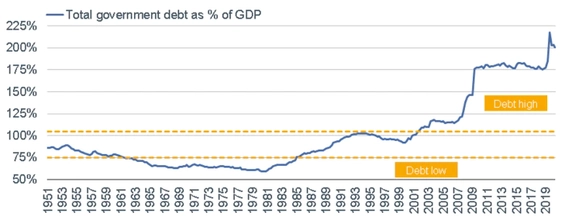

Source: Charles Schwab, Bloomberg, Federal Reserve, ©Copyright 2021 Ned Davis Research, Inc. Further distribution prohibited without prior permission. All Rights Reserved. See NDR Disclaimer at www.ndr.com/copyright.html. For data vendor disclaimers refer to www.ndr.com/vendorinfo/, as of 03/31/2021.
Is rising debt inflationary?
Although it’s not supported by any historical data, there is a persistent concern expressed about high debt and whether it will lead to an inflation problem. The visual below shows every decade since the 1970s—each color-coded—and the relationship between debt as a percentage of gross domestic product (GDP) and the inflation rate, as measured by the core personal consumption expenditures (PCE) measure (which is the Federal Reserve’s preferred metric). As you can see, as debt growth has expanded as a share of GDP, inflation has been moving lower, not higher.
While debt growth has expanded as a share of GDP, inflation has moved lower 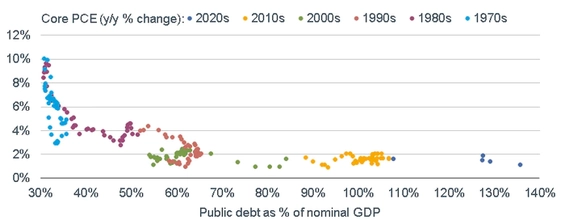
Source: Charles Schwab, Bloomberg, as of 03/31/2021.
Looking back further, the United States’ “net national savings” rate was relatively high coming out of World War II. But the United States had to finance itself internally after the war, given that Europe and Japan were all in dire financial straits. The difference today is that those and other countries have been more than willing to buy U.S. debt. In addition, the cost of servicing debt is currently historically low, so the Federal Reserve’s role in “financing U.S. debt” is occurring at a very low cost (even if there remains the potential for unintended negative consequences). In fact, as can be seen below, net interest payments are expected to continue to decline over the next couple of years, before accelerating again.
Interest on U.S. national debt is expected to decrease, then increase later this decade 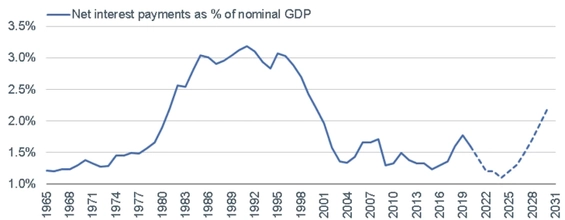
Longer term, the burden of interest payments is expected to accelerate, as shown above; based on estimates from the Congressional Budget Office (CBO), the projected growth rate in government spending on interest payments over the next decade will swamp the growth rate of other spending categories.
Net interest payments are projected to dwarf other government spending over the decade 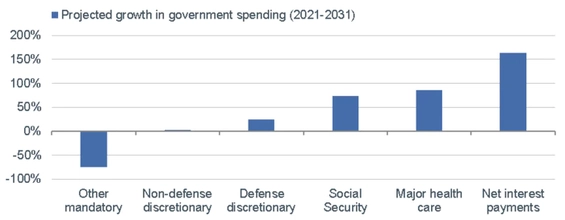
Net interest payments are expected to grow by more than 150% by the year 2031. By contrast, government spending on health care is expected to grow by 80%, on Social Security by 75%, on defense discretionary by 25%, on non-defense discretionary almost flat, and other mandatory spending is expected to drop by 75%.] Source: Charles Schwab, CBO (Congressional Budget Office): An Update to the Budget Outlook: 2021 to 2031 (2/11/2021).
More debt is unlikely to generate greater economic growth
Even under any future dire assumptions of the growth rate of net interest payments, we believe there is little to no risk of a U.S. debt default. In the meantime, there is generally an agreed-upon set of ways government can reduce its debt burden. One way, which the United States is currently employing (though not yet with a beneficial impact on debt growth) is typically referred to as “financial repression”—involving keeping interest rates extremely low, which keeps real yields in negative territory. Another way is for the government to reduce spending and/or increase taxes—at least in the case of the former, it’s presently a non-starter given the pandemic. Finally, the government can also try to boost growth and inflation, such that the denominator (GDP) is growing faster than the numerator (debt). That was exactly what happened in the late 1940s, just after WWII.
What we do know now is that as the debt ratio has soared, each additional dollar of debt is leading to significantly less than a dollar’s worth of economic growth. This is referred to as the “credit multiplier” or “money multiplier.” More debt is unlikely to generate greater economic growth, other than perhaps for a short span of time. The weight of debt also represents a weight on economic growth. For all the cheering of the last expansion being the longest on record (from June 2009 to February 2020), it was also the weakest on record, as you can see below.
The longest market expansion was also the weakest 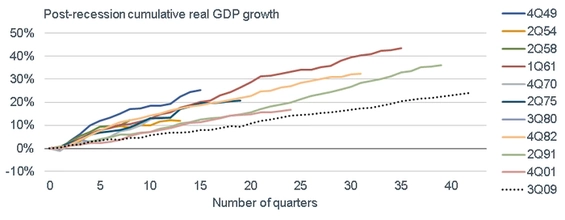
A key to durable economic growth likely will require an eventual move down in government debt ratios, which could trigger an expansion in the aforementioned credit multiplier. At present, however, there is growing (and bipartisan) support for continuing to kick the debt can down the road.
Important Disclosures:
The information provided here is for general informational purposes only and should not be considered an individualized recommendation or personalized investment advice. The investment strategies mentioned here may not be suitable for everyone. Each investor needs to review an investment strategy for his or her own particular situation before making any investment decision.
All expressions of opinion are subject to change without notice in reaction to shifting market, economic or political conditions. Data contained herein from third party providers is obtained from what are considered reliable sources. However, its accuracy, completeness or reliability cannot be guaranteed. This content was created as of the specific date indicated and reflects the author’s views as of that date. Supporting documentation for any claims or statistical information is available upon request.
Forecasts contained herein are for illustrative purposes only, may be based upon proprietary research and are developed through analysis of historical public data.
Past performance is no guarantee of future results and the opinions presented cannot be viewed as an indicator of future performance.
The policy analysis provided by the Charles Schwab & Co., Inc., does not constitute and should not be interpreted as an endorsement of any political party.

